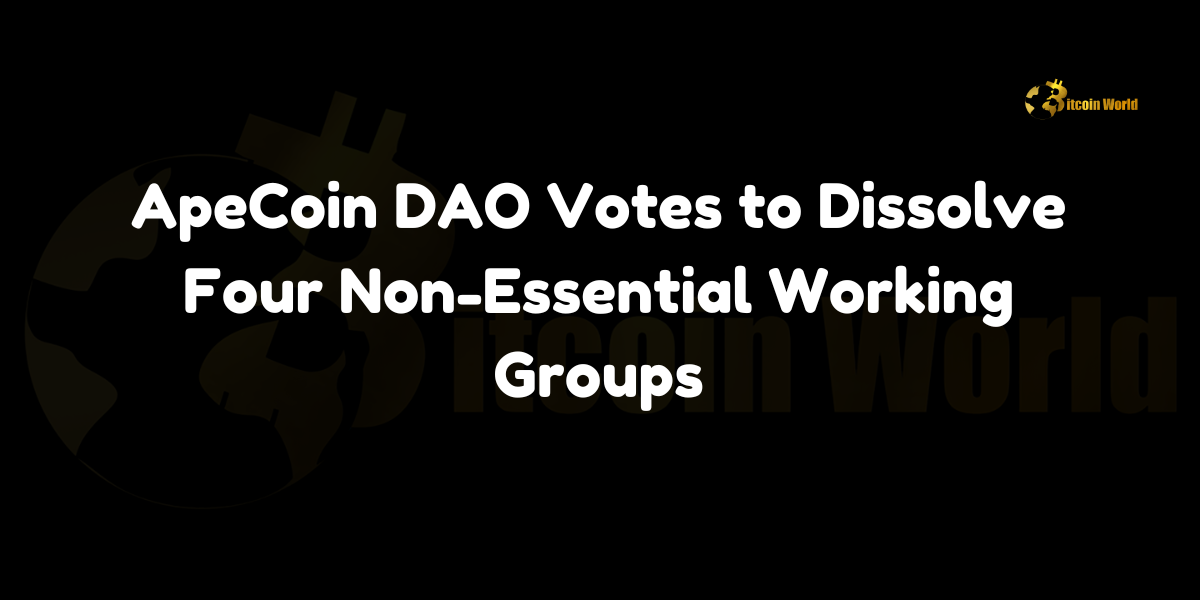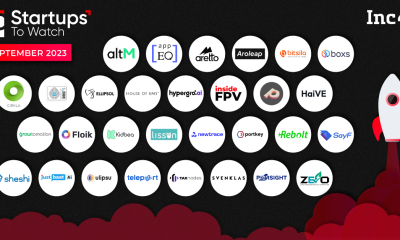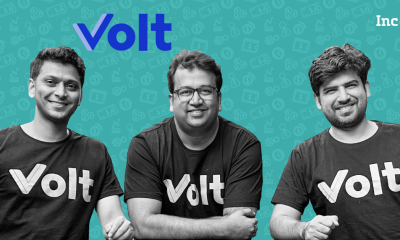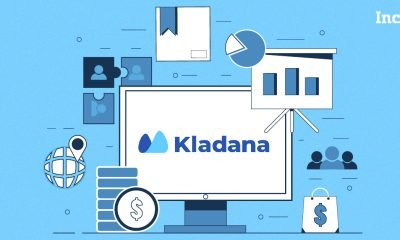Crptocurrency
ApeCoin DAO Votes to Dissolve Four Non-Essential Working Groups

In a move to streamline operations and reduce expenses, ApeCoin DAO has approved a proposal to dissolve four non-essential working groups. With 98.02% support from its community, the decision, as reported by Bitget Exchange, will eliminate groups focused on governance, marketing and communication, the metaverse, and Web3 development. These groups have reportedly cost the DAO around $3 million annually while proving inefficient in task execution, prompting the proposal to prioritize more strategic and essential activities within the organization.
Understanding the ApeCoin DAO and Its Structure
What is ApeCoin DAO?
The ApeCoin DAO governs the ApeCoin ecosystem, which is deeply tied to the Bored Ape Yacht Club (BAYC) and its broader NFT universe. The DAO allows community members to vote on proposals, manage resources, and direct the future of ApeCoin-related initiatives. Through decentralized governance, ApeCoin holders participate in key decisions, ensuring the project remains community-driven.
Role of Working Groups in the DAO
Within the ApeCoin DAO structure, working groups have been created to focus on specific areas, such as governance, marketing, metaverse development, and Web3 innovation. These groups were responsible for driving initiatives within their domains, helping to implement the DAO’s broader vision and goals. However, recent performance evaluations revealed inefficiencies, leading to the proposal to dissolve some of these groups.
Details of the Proposal and Voting Results
Proposal to Dissolve Four Working Groups
The approved proposal specifically targeted four non-essential working groups that had become cost-prohibitive and inefficient in executing their tasks. These groups included:
- Governance Working Group: Responsible for facilitating the governance processes of ApeCoin DAO, including voting and proposal execution.
- Marketing and Communication Working Group: Tasked with managing the DAO’s public relations, branding, and external communications.
- Metaverse Development Working Group: Focused on expanding ApeCoin’s presence and partnerships within metaverse projects.
- Web3 Development Working Group: Charged with advancing Web3 integrations and decentralized applications (dApps) for the ApeCoin ecosystem.
Voting Outcome: Overwhelming Support for Dissolution
The proposal received overwhelming support from the ApeCoin community, with 98.02% of voters in favor of dissolving the four groups. This clear mandate highlights the community’s recognition of the need for more efficient and cost-effective operations.
Financial Implications: Saving $3 Million Annually
One of the primary drivers behind the proposal was the financial burden posed by the working groups. Collectively, these groups were costing the DAO approximately $3 million annually. Dissolving them will allow the DAO to reallocate resources to more impactful and strategic initiatives, enhancing the long-term sustainability of the ecosystem.
Reasons for Inefficiency and Group Dissolution
Underperformance and Task Execution Challenges
The working groups in question were found to be underperforming, struggling to execute their assigned tasks effectively. Delays in project timelines, lack of measurable outcomes, and ineffective use of resources contributed to their dissolution. By eliminating these groups, the DAO aims to streamline operations and focus on areas where tangible progress can be made.
High Costs Relative to Output
The $3 million annual expense was deemed excessive, especially when considering the lack of significant results from these groups. The proposal noted that the funds could be better spent on high-impact projects or improving core areas of the ApeCoin ecosystem that directly benefit the community.
Refocusing on Strategic Priorities
The dissolution of these groups signals a strategic shift within the DAO, prioritizing essential activities that align with its long-term vision. Instead of spreading resources thinly across multiple working groups, the DAO can now concentrate on initiatives that deliver the most value to ApeCoin holders and the broader ecosystem.
Implications for ApeCoin DAO and Its Future Direction
Streamlining Operations
The dissolution of non-essential working groups allows the ApeCoin DAO to streamline operations and reduce bureaucratic overhead. This move is expected to improve decision-making efficiency and speed up the execution of critical initiatives.
Cost Efficiency and Resource Allocation
With the $3 million annual savings, the DAO can reallocate funds to more impactful projects. These could include development in key areas like community engagement, technological innovation, and partnerships that drive real value for the ecosystem.
Focus on Core Projects
By cutting down on ineffective working groups, the DAO can now focus on core projects that are integral to its growth. These may include enhancing ApeCoin’s utility within the Bored Ape Yacht Club ecosystem, developing partnerships in the metaverse, or supporting DeFi and NFT innovations.
Community Empowerment
The overwhelming support for the proposal reflects the community’s desire for a more efficient and results-driven DAO. By empowering the community to make key decisions, the DAO strengthens its decentralized governance model and ensures that members’ interests are at the forefront of its strategic direction.
Challenges and Considerations
Managing the Transition
While the dissolution of these groups is expected to have positive long-term effects, managing the transition will be crucial. Ensuring that ongoing projects are either completed or transitioned smoothly to other groups or structures will be necessary to avoid disruption.
Maintaining Communication and Governance Efficiency
Although the governance and marketing working groups have been dissolved, it remains essential for the DAO to maintain effective communication with its members and ensure transparent governance processes. New mechanisms may need to be implemented to handle these functions without relying on the dissolved groups.
Ensuring Strategic Focus
With the dissolution of the Web3 and metaverse development groups, the DAO must ensure that strategic focus on these emerging technologies is not lost. Finding alternative ways to drive innovation in these areas, possibly through new partnerships or internal teams, will be essential for maintaining momentum in these crucial sectors.
Future Outlook for ApeCoin DAO
Restructuring for Growth
The decision to dissolve non-essential working groups indicates that the ApeCoin DAO is restructuring for growth. By focusing on core areas and improving resource allocation, the DAO is positioning itself for sustained development and long-term success within the NFT, metaverse, and Web3 spaces.
New Opportunities for Community Involvement
As the DAO evolves, there will likely be new opportunities for community members to get involved in shaping its future. Whether through the formation of new working groups, advisory committees, or direct voting on proposals, the ApeCoin DAO continues to empower its members and prioritize decentralized decision-making.
Potential New Initiatives
With additional funds now available, the DAO could launch new initiatives focused on increasing ApeCoin’s utility, improving governance systems, or fostering innovation within the ecosystem. These initiatives could include investments in new decentralized applications (dApps), collaborations with other blockchain projects, or enhancing the ApeCoin marketplace.
Conclusion
The dissolution of four non-essential working groups by ApeCoin DAO represents a significant step toward operational efficiency and cost management. With overwhelming community support, the DAO is set to save $3 million annually, allowing for the reallocation of resources to more impactful projects. By streamlining its structure, ApeCoin DAO can now focus on core initiatives that drive growth, enhance utility, and strengthen its position within the decentralized finance and NFT landscapes.
This move marks an important transition for the DAO, one that prioritizes long-term sustainability, strategic focus, and community empowerment. As the DAO continues to evolve, the decisions made today will shape the future of ApeCoin and its ecosystem for years to come.
To learn more about the innovative startups shaping the future of the crypto industry, explore our latest news article, where we delve into the most promising ventures and their potential to disrupt traditional industries.
Disclaimer: The information provided is not trading advice, Bitcoinworld.co.in holds no liability for any investments made based on the information provided on this page. We strongly recommend independent research and/or consultation with a qualified professional before making any investment decisions.
Crptocurrency
Voce Sabia to Launch $VS Token, Expanding the Celebrity-Backed Meme Token Trend in Brazil

Dubai, United Arab Emirates, October 17th, 2024, Chainwire
Voce Sabia, the fourth-largest content creator in Brazil with over 45 million subscribers on YouTube and a combined social media following of 86 million, is set to launch its own meme-inspired cryptocurrency token, the $VS token. With this launch, Voce Sabia joins a growing list of celebrities leveraging their platforms to introduce digital tokens, including rapper Iggy Azalea, whose token, $MOTHER, reached a peak market capitalization of $136 million.
Since the May release of Iggy Azalea’s $MOTHER token, which provided early adopters with substantial returns, celebrity-driven tokens have gained traction within the Web3 space. The success of these tokens can be attributed to the large and highly engaged communities that creators bring to the table. Capitalizing on the trend, Voce Sabia aims to use its substantial fanbase to drive the $VS token, leveraging a community that is nearly double in size compared to Azalea’s combined following.
The $VS token will launch through a fair release on the Solana blockchain. It boasts an initial market cap of just $25,510, setting the stage for accessible entry points for fans and potential investors. This launch will be powered by the XCAD Network, a platform dedicated to helping content creators issue tokens while building ecosystems around their unique brands. The XCAD Network has successfully supported various creator token launches, enabling the $VS token to offer unique fan engagement opportunities.
 Comparison Graphic released by Voce Sabia’s Social Media Team.
Comparison Graphic released by Voce Sabia’s Social Media Team.
The $VS token will give Voce Sabia’s community access to exclusive content, including merchandise, one-on-one calls, and other interactive opportunities, fostering deeper connections between the creator and their followers. Moreover, $VS holders will have governance rights, enabling them to participate in selected decisions regarding the channel’s future direction.
The entry of Voce Sabia into the meme token arena is emblematic of a larger movement among public figures integrating Web3 technologies to engage their fans on new levels. The trend highlights the appeal of combining meme culture with strong social media followings, driving user engagement and fostering active communities.
For more information and to stay updated on the $VS token launch, Voce Sabia has provided links to its official communication channels:
Twitter: https://x.com/Vocesabiatoken
Telegram: https://t.me/vocesabiatoken
WhatsApp: https://www.whatsapp.com/channel/0029Vaq3U7hJENxzmKNrnV00
Contact
Jeff Sa
Memespotlightorg@outlook.com
Disclaimer: The information provided is not trading advice, Bitcoinworld.co.in holds no liability for any investments made based on the information provided on this page. We strongly recommend independent research and/or consultation with a qualified professional before making any investment decisions.
Crptocurrency
Aleph Zero Launches Subsecond Shielding on Testnet, Delivering Client-Side ZK Privacy for DeFi

Zug, Switzerland, October 17th, 2024, Chainwire
Most zero-knowledge proofs are generated server-side for scaling, but Aleph Zero’s zkOS does that directly on users’ devices, offering privacy in a fraction of second
Aleph Zero, the leading blockchain platform recognized for its focus on privacy and scalability, announces the launch of the first feature of zkOS (zero-knowledge operating system)—Shielding, on its EVM Testnet. This release marks the first opportunity for users to experience the shielding feature of zkOS in action, demonstrating the speed and privacy capabilities of Aleph Zero’s zero-knowledge proof (ZK) technology optimizations.
Privacy at Lightning Speed
The Shielding Demo release is a significant milestone for Aleph Zero, representing its commitment to developing practical privacy solutions for the blockchain industry. Aleph Zero’s zkOS enables zero-knowledge proofs to be generated client-side—meaning data is encrypted locally on the user’s device and never leaves unencrypted—providing high levels of privacy without compromising transaction speed. The Shielding Demo serves as the first practical interface for users to experience this privacy functionality, with zero-knowledge proofs generated within 0.5-3 seconds, ensuring that privacy has minimal impact on transaction performance.
“Privacy has long been a challenge in blockchain, often due to poor user experience,” said Adam Gagol, Co-Founder & CTO of Aleph Zero. “With today’s release, we’re delivering one of the fastest client-side ZK directly to users, combining privacy and performance. The release of the Shielding Demo offers a glimpse into how zkOS can bring privacy to DeFi without sacrificing speed or usability.”
How the Shielding Demo Works
The Shielding Demo provides an intuitive interface for users to test Aleph Zero’s zkOS privacy layer. Here’s how it works:
- Data Privacy: zkOS generates zero-knowledge proofs locally on the user’s device, ensuring that data remains private and secure.
- Transaction Flow: Users generate ZK proofs, send transactions to a relayer, and then they are executed on-chain—all while maintaining privacy.
- Fast Proving Times: The system delivers ZK proofs in 0.5-3 seconds on most devices, demonstrating zkOS’s speed and its minimal impact on transaction times.
The Testnet version of zkOS allows users to interact with the system and witness its capabilities, though Aleph Zero notes that the privacy features will be built directly into the upcoming Common app.
Why zkOS Matters: A Glimpse Into the Future
The launch of the Shielding Demo on Testnet is only the beginning. Aleph Zero’s roadmap for zkOS extends far beyond this initial release, with ongoing work on simplifying the user experience and the introduction of additional privacy features, such as ZK-ID and anonymity revokers, to ensure both privacy and protection against fraudulent use of the platform.
The system is designed to be easily integrated by developers, providing a privacy framework that requires minimal cryptographic knowledge. This simplicity, combined with Aleph Zero’s rapid client-side ZK proof generation, makes zkOS a critical tool for developers building privacy-centric applications across DeFi and other web3 sectors.
Unlocking Privacy for New Use Case
The privacy space in blockchain has been facing increased challenges, such as regulatory scrutiny and delistings, often due to concerns over non-compliance. Aleph Zero’s zkOS offers a fresh approach by delivering privacy solutions that balance user confidentiality with regulatory requirements. Instead of focusing solely on anonymity, zkOS is designed to meet both the needs of users and the evolving demands of compliance.
zkOS enables users to manage their assets securely across multiple blockchains, ensuring their transactions remain private. Unlike traditional privacy methods that rely on centralized or hardware-based systems, zkOS operates directly on the client-side, safeguarding privacy without external dependencies.
Next Steps for Aleph Zero
As the Testnet release progresses, Aleph Zero is focusing on refining Shielding and zkOS for its Mainnet deployment. Users who engage with the Shielding Demo will have the opportunity to be whitelisted for upcoming zkOS Beta testing on Aleph Zero’s EVM Mainnet.
About Aleph Zero
Aleph Zero is an ecosystem of blockchain solutions that are engineered for speed, data confidentiality, and ease of development. It achieves efficiencies akin to conventional web2 systems, upholds rigorous standards for data protection via zero-knowledge proofs (ZKP), and offers a comprehensive toolset for development across web3, ranging from WASM-based Rust to EVM-based Solidity environments. Aleph Zero’s versatility is highlighted by over 40 use cases being actively developed, showcasing its adaptability across various sectors and applications. These use cases are part of an engaged community and growing ecosystem of web3 applications supported by Aleph Zero programs.
For more information, visit https://alephzero.org/.
For any inquiries about this release, please contact josh@serotonin.co or ana@serotonin.co.
Contact
PR Manager
Josh Adams
Aleph Zero
josh@serotonin.co
Disclaimer: The information provided is not trading advice, Bitcoinworld.co.in holds no liability for any investments made based on the information provided on this page. We strongly recommend independent research and/or consultation with a qualified professional before making any investment decisions.
Crptocurrency
DeBridge Launches DBR Governance Token with Airdrop to Nearly 500,000 Users

In a major development for the cross-chain ecosystem, DeBridge, a prominent cross-chain infrastructure provider, has launched its governance token, DBR, with a significant airdrop to nearly 500,000 early users and community members. According to CoinDesk, the token was built on Solana and has an initial circulation of 1.8 billion tokens out of a total 10 billion maximum supply. The launch marks a pivotal moment for DeBridge as it seeks to decentralize governance and empower its community. Trading for DBR started at $0.03 per token, with the token targeting a fully diluted valuation of $300 million.
Understanding the DBR Governance Token
What is DBR?
DBR is the governance token for the DeBridge ecosystem, designed to allow token holders to participate in governance decisions, such as protocol upgrades, network parameters, and the direction of the platform. By introducing DBR, DeBridge aims to decentralize control over its cross-chain infrastructure and create a more community-driven decision-making process.
Tokenomics of DBR
- Maximum Supply: 10 billion DBR
- Initial Circulation: 1.8 billion DBR (18% of the total supply)
- Airdrop Distribution: Nearly 500,000 early users and community members were selected to receive DBR tokens through an airdrop.
- Initial Price: $0.03 per token
- Fully Diluted Valuation (FDV): $300 million
The distribution of DBR through an airdrop incentivizes early participants and supporters of the DeBridge ecosystem, rewarding them for their contributions and engagement. The airdrop is being conducted in two phases, and recipients must adhere to specific conditions to claim their tokens, including penalties for early full withdrawals.
Phased Airdrop and Withdrawal Penalties
Two-Phase Airdrop Distribution
DeBridge’s airdrop distribution is structured in two phases to ensure that tokens are distributed fairly and to incentivize long-term participation:
- Phase 1: Eligible users can claim a portion of their DBR tokens initially, but only a percentage of the total allocation will be available for immediate withdrawal.
- Phase 2: In the second phase, users can claim the remaining portion of their airdropped DBR tokens. However, penalties apply to users who attempt to withdraw all their tokens early, discouraging short-term speculation and encouraging long-term holding.
The penalty mechanism is designed to promote the stability of the DBR token and prevent rapid selling that could destabilize the token’s market value.
Encouraging Long-Term Engagement
By implementing a phased airdrop with penalties for early withdrawals, DeBridge aims to foster long-term community engagement. This approach encourages token holders to remain active participants in the DeBridge ecosystem and contribute to the governance and growth of the platform over time.
The Role of DBR in DeBridge Governance
Decentralizing Governance
The introduction of the DBR token is a significant step toward decentralizing governance within the DeBridge ecosystem. Token holders will have the power to vote on key governance proposals, including:
- Protocol Upgrades: Proposals to enhance DeBridge’s cross-chain capabilities and infrastructure.
- Network Parameters: Adjustments to transaction fees, security mechanisms, and other core network settings.
- Community Initiatives: Voting on grants, partnerships, and other initiatives that promote the growth of the DeBridge ecosystem.
By giving the community a direct say in the governance process, DeBridge aims to create a more inclusive and decentralized decision-making framework.
Incentivizing Participation
DBR token holders will be incentivized to participate in governance through staking and voting rewards. By actively engaging in the governance process, users can earn additional DBR tokens and contribute to the long-term success of the DeBridge platform. This creates a positive feedback loop where active governance participation leads to increased rewards and influence within the ecosystem.
Trading and Market Impact
Initial Trading and Market Performance
DBR began trading at $0.03 per token, with an initial fully diluted valuation of $300 million. Early trading volumes have been strong, reflecting significant interest in the token from both airdrop recipients and the broader cryptocurrency community.
Potential for Price Volatility
As with many newly launched tokens, DBR is expected to experience price volatility in its early trading days. The phased airdrop and withdrawal penalties are designed to mitigate some of this volatility by discouraging short-term speculation and promoting long-term holding.
Long-Term Growth Prospects
The long-term growth prospects for DBR are closely tied to the success of the DeBridge platform and its cross-chain capabilities. As DeBridge continues to expand its services and partnerships, the utility and demand for DBR are likely to increase. Additionally, as more users participate in governance and staking, the circulating supply of DBR could become more distributed, further stabilizing the token’s price.
The Importance of Cross-Chain Infrastructure
DeBridge’s Role in the Cross-Chain Ecosystem
DeBridge is a cross-chain infrastructure provider that enables seamless interoperability between different blockchain networks. As the cryptocurrency ecosystem becomes more fragmented across multiple chains, cross-chain solutions like DeBridge are essential for ensuring that assets and data can move freely and securely between networks.
By launching a governance token, DeBridge is decentralizing control over its infrastructure and empowering the community to shape the future of cross-chain interoperability. This move aligns with the broader trend in the crypto space toward decentralization and community-driven governance.
Enhancing Cross-Chain Collaboration
The DBR token will play a crucial role in enhancing cross-chain collaboration by incentivizing community members to participate in governance decisions that improve interoperability between blockchain networks. As more projects and users adopt DeBridge’s services, the importance of cross-chain governance will continue to grow, making DBR a key player in the evolution of decentralized finance (DeFi).
Conclusion
The launch of the DBR governance token by DeBridge marks a significant milestone in the platform’s journey toward decentralization and community-driven governance. With an airdrop to nearly 500,000 early users, the DBR token aims to empower the community to take an active role in shaping the future of cross-chain infrastructure. By introducing phased distribution and withdrawal penalties, DeBridge is encouraging long-term engagement and discouraging short-term speculation, ensuring the stability of the DBR token.
As DeBridge continues to expand its cross-chain services and partnerships, the demand for DBR is expected to grow, making it an integral part of the platform’s governance and ecosystem. With its initial trading price of $0.03 per token and a fully diluted valuation of $300 million, DBR has already captured the attention of the crypto market, and its future looks promising as cross-chain solutions become increasingly essential in the decentralized finance landscape.
To learn more about the latest developments in cross-chain infrastructure and governance tokens, explore our latest news article, where we discuss the key trends shaping the future of decentralized finance.
Disclaimer: The information provided is not trading advice, Bitcoinworld.co.in holds no liability for any investments made based on the information provided on this page. We strongly recommend independent research and/or consultation with a qualified professional before making any investment decisions.
-

 Startup Stories1 year ago
Startup Stories1 year agoWhy Millennials, GenZs Are Riding The Investment Tech Wave In India
-

 Startup Stories1 year ago
Startup Stories1 year agoStartups That Caught Our Eyes In September 2023
-

 Startup Stories1 year ago
Startup Stories1 year agoHow Raaho Is Using Tech To Transform India’s Fragmented Commercial Trucking
-

 Startup Stories11 months ago
Startup Stories11 months agoMeet The 10 Indian Startup Gems In The Indian Jewellery Industry’s Crown
-

 Crptocurrency8 months ago
Crptocurrency8 months agoLither is Making Crypto Safe, Fun, and Profitable for Everyone!
-

 Startup Stories1 year ago
Startup Stories1 year agoHow Volt Money Is Unlocking The Value Of Mutual Funds With Secured Lending
-

 E-commerce1 year ago
E-commerce1 year agoTop Online Couponing Trends To Watch Out For In 2016
-

 Startup Stories1 year ago
Startup Stories1 year agoWhy Moscow-Based Kladana Considers Indian SME Sector As The Next Big Market For Cloud Computing




